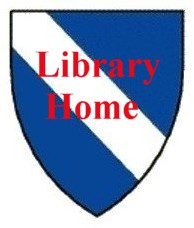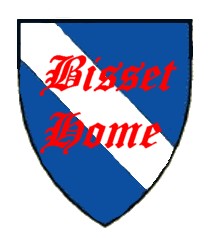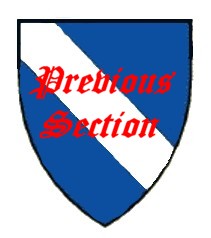
Chapter 2:
The Origin of the Bissets

 |
Chapter 2:
|

|
The name has been recorded in numerous ways, Byset, Biseys, Bysey, Biset, Bisset and I have chosen to use the form Bisset as common throughout.
According to James Coutts in his book “The Anglo-Norman Peaceful Invasion of Scotland. 1057-1200, published 1922 by Andrew Kinross, the family originally came from Villa Thancardi, Bissy, Cote de Or. From what source he deduces this is not known but the area Cote de Or is in central France around the area of Dijon and if this is correct then their Norman origin may well be pre-dated by an earlier Bugundian one.
There are all sorts of reasons as to how the Bissets may have arrived in Normandy, a possibility is as part of a supporting group to the new wife of a lord such as William Talvas II, Count of Ponthieu who married into the ducal house of Burgundy – they may just have moved to further their ambitions but we know that before his death c1180 Arnulf Bisset was already Lord of Bretizel (NF, p491) which was right on the border of 12c Normandy and Ponthieu and adjacent to Aumale so the feudal connection between Aumale and Bisset may well predate this by two generations if not three.
I also have an unsubstantiated email report by a Bisset claiming that their Norman home was Boissay, a hamlet to the north east of Rouen and I wonder if this could be confused with Vieux- Rouen a location close to Bretizel not that far from the holdings of Aumale and Flemish influence.
Beryl Platt in her book The Scottish Hazard makes the provocative point that past historians have too often taken at face value that anyone who came from Normandy was Norman. This is again emphasized by R.A. Brown in “The Normans”. But had historians looked at where the “Normans” had come from before they would have found that a significant number came from and or had important Flemish connections (and other) which can be proved both by heraldry and family connections via marriage etc. The point being that the term Norman was more generic than ethnic at this period
She also demonstrates that these Flemish families worked across borders and feudal hierarchy as a form of “freemasonry” helping each other and marrying within an overall Flemish dimension. So it’s not impossible but not proven that the Bissets had some Flemish link and the Aumale connection is a pointer in this direction.
The Bissets may have originated in the Cote de Or and the name Bissy is indicative
that this may be true but to a large extent this is immaterial; the fact is
that the family of Bisset first came to notice in Normandy, some of the early
family being in feudal service to the Count of Aumale and later when Manasser
Bisset became Steward to Henry, Duke of Normandy who later became King Henry
II of England, they really took off in England.
Dugdale (B. vol. i p.632.) states that the first mention of the name Bisset
in England was in the 12th year of the reign of King Stephen, when Manasser
Bisset was one of the witnesses to the accord made between Stephen and Henry
Duke of Normandy, touching the succession of the latter to the crown of England.
Manasser would have been acting at this time as Henry’s steward and trusted
enough by Stephen it seems be part of these negotiations. It is possible that
Manasser may even have been in Stephens employ prior to Henrys.
It is important not to get too involved with our concept of national boundaries
and the concept of nationhood. To a knight of Christendom national boundaries
did not hold the same connotations as they do to us - the lord they were in
feudal service to was of more importance. It does seem however that from the
early 12th C. the family had connections on both sides of the Channel, perhaps
not surprisingly as the Norman Empire was represented in England, Ireland, Scotland
and Normandy also Italy, Sicily and Outremer and crossed what we would see as
national boundaries.
Coutts states that the Bissets spelt their name Bysey and Byset in the “Roll of Battle Abbey”. This Roll is claimed to hold the names of all the Norman families that were at the Battle of Hastings. It was a roll call of all who had embarked at St Valeries with Duke William, and was hung in the Abbey built by the Conqueror as an evidence of pious gratitude for his success
The fate of this document is a mystery; the abbey and lands passed to Sir Anthony Browne, an ancestor of the Viscounts Montague who sold them to Sir Thomas Webster who lived at Cowdray House, Midhurst, Sussex. Cowdray House was totally destroyed by fire in 1792 and the assumption is that the Roll was lost in this fire. Of nearly a dozen writers who furnish lists in the sixteenth and seventeenth centuries, Mark Lower, the author of “Essay on Family Nomenclature” who is considered a competent authority, thinks that Leyland should stand first in accuracy, as he saw and transcribed the original. “It should be remembered that the surname was a thing of development, and in some cases it would be difficult to identify the holder of it with a Norman progenitor.” I have inspected the lists given by Holinshed, (who has a Bysey) whereas John Fox and Leyland do not. I personally find all these copies very hard to accept as to their historic accuracy and feel that it must be safer to dismiss them completely as reliable historical documents.
It is claimed that in succeeding centuries the Roll was extensively manipulated,
but there is no special reason to assume that any member of the Bisset family
was at Hastings or why at a much later period their name should have been added.
Had a Bisset actually arrived with Duke William they appear not to have prospered
or benefited, perhaps a very short stay!
Mr H. Barber in his British Family Names thinks that all those names found in
Domesday Book of 1086 may reasonably connect their first representative with
the event [Hastings]. Among the names standing this test he has Bisset and Grant.
It would be interesting to know where in the Domesday Book these references
are found as I have totally failed to find any such names in any of the detailed
analysis of the book now available. In the case of the Grants, he may well be
confused with the family of Le Grand-Mesnil, or Grentmesnil, there is no evidence
to link this family with the Grants.
While millions of people in the English speaking world must by definition be descended from the conquering army of William of Normandy, only 15 individuals can be proved to be or extremely probably be Companions of the Conqueror [The Falaise Celebrations 1931. Genealogists Magazine, vol. 5, pp 394-397.] and being present at Hastings and if we ignore the “Role of Battle Abbey”, as at the best a suspect document, we can see that to prove descent from the invading Norman army is next to impossible. It is easier to prove descent from William I.
The other main source is the “Doomsday Book,” of 1086; this book records most of England as a basis for taxable assessment but also shows who the owners were at the date of the survey and who had previously held it prior to 1066. The transfer of ownership from Saxon to Norman is evidence that the new owner owed his title to his support of the Norman regime regardless as to whether or not we can prove that they took part in the actual Battle at Hastings. What it does clearly indicate is that those people of non Anglo-Saxon origin who held land recorded in the “Doomsday Book” were part of the first and probably more important wave of settlers associated with the Conquest and a family name found or one that can be positively traced to a name in this book is a clear indication of continental and most likely Norman descent. [I use the term Norman, but this would include Flemish, Bugundian etc any follower of William’s army]
The Bisset family if it did indeed arrive from France around the time of the Conquest appears to have survived in England without any notice or mention, an unlikely situation.
William Bisset first appears in England in 1131 and in Normandy; Manasser Bisset one of his four sons is noted as steward (1153) to Henry, Duke of Normandy, and later Henry II of England. This was initially a post in Normandy and we know he witnessed charters at Chateau-du-Loir and Falaise in 1151 and 1153. He came to England with Henry on his accession to the English throne and was one of his most frequent witnesses to his Acts. If he was involved in the negotiations with Stephen he would very likely have been in England at that time and he and his wife started the Lazar Hospital in Bradley in 1152 two years prior to Henry II’s accession. This shows that he was already married to Alice du Cany and that he was a regular visitor to England prior to the accession. He continued in the office of Steward until his death 1177/8. As early as 1156 he held lands in Hampshire Worcestershire, and Wiltshire. (Pipe roll 2, Hen. Ii, p54) I have seen an unsubstantiated report that Manasser at one time held 200 manors in England how true is hard to say but he almost certainly held more than those which I am currently aware of.
He had married Alice de Cany, sister and heir of Gilbert de Falaise. Alice de Cany was related to the Gifford family and as a relative of Walter Gifford, 2nd Earl of Buckingham, she brought as part of her dower, Bradley in Somerset to the marriage. And it would be by this connection that Manasser held one knight’s fee of Gifford at Bradley this fee later being fixed at £1 per annum. They had a son Henry, probably named after the King, who later with the loss of Normandy adhered to King John, at which point the Normandy connection was broken and the future for the Bissets was in England Scotland and Ireland.
There is now “evidence” [Domesday Descendants A Prosopography of Persons Occurring in English Documents 1066-1166. by Dr K. S .B. Keats-Rohan. 2002.] that William Bisset and his wife Hawise, parents of both Manasser and William Bisset were tenants in Derbyshire and Nottinghamshire of Stephen, Count of Aumale, Lord of Holderness and successor of Drogo de Beuvriere.
My own view is that without further supporting evidence the Bissets were not at Hastings and their first known arrival in England dates from the mention of a knight named Bisset in the service of the Archbishop of Canterbury in 1093-96 whose exact line and position in the overall Bisset family is not known. Whoever he was he pre-dates William Bisset and might have been his uncle and brother to Henry Bisa. The mention of William Bisset in English documents 1131. [Pipe Roll 31 Henry i.] is the first Bisset whose line of descent we can follow in England.
One of the great problems in unravelling and understanding the early Bissets
is their use of a very restricted number of Christian names, Henry, William,
and John occurring sometimes in three continuous generations; a custom common
in Norman medieval families. This coupled to the fact that we can only pick
up those members who appear in recorded documentation, we know that we must
be missing family members solely because any documentation containing their
name has not survived or been recognised or they may never have been recorded
anyway. It is to Manasser Bisset and his brothers William and Henry that we
must look to for the future development of the family in England and to a less
extent Scotland.
 |
Chapter 2:
|

|